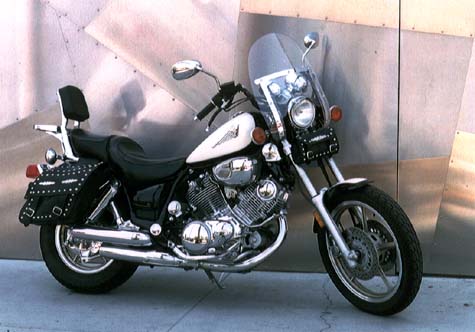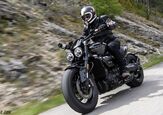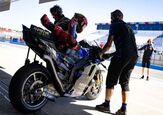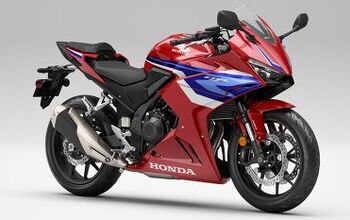1996 Yamaha Virago 1100 Special - Motorcycle.com
Few motorcycles can boast the heritage of Yamaha's Virago: The first version of this machine was introduced in 1981, four years before Harley-Davidson's Evolution engine hit the scene. The Virago even had a Softail-style suspension back then, though it was actually just Yamaha's clunky mono-cross single-shock tail, which later bowed out for a more fashionable twin-shock setup. Could all this have been the seminal influence for the Harley designers of the Reagan era?Well, probably not. But it tells how long the Virago has been around. Perhaps the Virago has survived so long in Yamaha's lineup because of its low profile. Certainly, the styling doesn't scream "Harley Clone" or "Nostalgia Cycle," but rather allows the rider to make his or her own mind up. In a decade and a half the twin's engine has grown from 750 to 1100cc, and the few minor bugs it originally had have been fixed. The result is the well-sorted unit found in the 1996 Virago 1100 Special. The motor dominates the Special in every way. Cosmetically, the engine's numerous chromed pieces draw attention to the V-twin. Without a downtube out front, the forward cylinder seems to be bursting free from the chassis. The nicely swept front header only emphasizes the point.
Once you actually ride the bike, the engine continues to dominate the experience, and that's a good thing. Quite simply the bike has more than enough power -- all the time. Twist the throttle, any time, any gear, and the bike pulls forward eagerly. It will even rev to 7000 rpm with only minimal complaint, though at this elevated engine speed it seems you can half-hear the engine muse about the psyche of anyone who would run it above 4000 rpm. The bike will even pull wheelies off the line: rev it up, dump the clutch, and the front wheel will loft every time. In other words, the motor is what you would expect from those wonderful folks who gave you the V-Max.
And when it comes time to stop or turn, you can almost hear those same wonderful folk saying "see, we can even make it handle, too." The front discs are a pair of purposeful-looking (if small) drilled rotors that haul the Virago down from speed only at the expense of a somewhat wooden feel and high lever effort. With a firm four-finger squeeze there is good retardation available, but it is almost immediately sabotaged by the stock Bridgestone Exedras, which will squeal and lock up well before maximum braking effort is found. At least when the front does lock up, it does so undramatically; ease off the brake and you're ready to grab some more. Out back the rear tire locks even more easily than the front, shortchanging the rear drum's excellent stopping power. Overall, we found the big Virago to have good brakes with useful feel; it's the OEM Bridgestones that disappoint.
The Virago's handling is as good as you'd expect from a long wheelbase cruiser. When you build a bike with a low seat height and raked-out forks as design features, it's unfortunately true that ground clearance and flickability cannot always be part of the package. This is somewhat true of the Virago. Once the rebound damping is clicked up to position 3 or 4 (something that can be adjusted from the seat at a stop light), the rear shocks handle the task of keeping the rear end on the road admirably. The engine is still able to have its way with the rear wheel thanks to the rear drive shaft and crummy tires, but the shaft effect is not unusually disconcerting. The front end pogos when pressed, sacrificing handling for a softer ride. The low speed handling and stability, however, are superb. It is easy to roll the machine through a U-turn so tight the inside peg scrapes.
Ergonomically, the Virago is sound. The broad and thickly padded stock seat looked and felt pretty good. It was a pleasant place to put one's rear end as the miles rolled by, though as with all cruisers, a bedroll behind your back is the hot ticket for comfort on a long ride. Fortunately for your sagging stomach muscles, the smallish gas tank requires a stop every hundred miles or sooner.
Handling and roadholding are secondary though, to the cruiser aficionado. First and foremost, is the look. If you feel like changing the look of your Virago, there are numerous choices available from Yamaha's accessories catalog. The company didn't have to offer us twice. We ordered up a bevy of pieces to sample on our 1100 Special.
The windshield was excellent, raising the freeway comfort level to a license busting 85 mph, at which point handlebar vibration and not the wind ended the fun. The fork-mounted tool pouch also cleaned up the front end, and even freed up a small amount of space in the rear tool box under the sissy bar. About enough to stow half a sandwich as emergency rations. We needed more, so on the back of the sissy bar we mounted Yamaha's sturdy parcel rack which was cosmetically inobtrusive and looked as if it belonged. The leather lever covers were less successful: after only a few days, the clutch-side cover rotated and slipped loose, thus looking more street punk than street cruiser. The cover ties were not leather, but rather some sort of nylon strands encased in rubber. They soon frayed.
The saddle bags disappointed. The shock-tower-following lines made it almost impossible to get a substantial load aboard. The bags won't hold an 8x10" envelope without bending it, the zipper-covered-by-two-buckles closure system is fussy, and the bags won't win any style contests. Oh well, back to the bungees.
We also decided to order up one of Corbin's Dual Touring Saddles. The first thing we noticed about this saddle was how narrow it was. Breaking out the tape measure, we found it to be about two inches narrower than the original. The DTS also has a nice, deeply scooped profile, while the stock seat is rounded, with a nearly convex seating surface that caused some staffers to howl in pain after a couple lengthy stints in the saddle.
Installation of the Corbin DTS was simple, as the seat is a bolt-on replacement for the stocker. We had some minor fiddling to do with fitting the seat to the bike, but didn't need to bend or cut anything to make the seat slide on. The DTS has a distinctive diamond pattern stitched into the seat; whether it is better than the clean lines of the stock unit is a matter of taste. Corbin recommends a 2000-mile break-in period for its saddles, so we'll let you know how it feels once sufficiently pounded by the rapidly spreading editorial backside.
Cruisers are in a class by themselves, when it comes to comparison. There are no empirical rules, no performance guidelines each bike must pass, and as far as we can see, no reason why the eighties-style Virago is any more or less up to date than the fifties styled cruisers now coming out of Japan. What can we say? So far, the bike is a very enjoyable ride. Sometimes you wonder about the the looks of the Virago, and maybe even wish for better tires or a better-damped front end. But twist the throttle, and you remember why this big twin is so much fun.
Specifications:
Manufacturer: YamahaModel: XV1100 Virago SpecialPrice: 99 (U.S.)Engine: Air-cooled SOHC, 75 degree V-twinBore x Stroke: 95.0 x 75.0 mmDisplacement: 1063ccCarburetion: Dual 40mm MikuniTransmission: 5-speed - shaft driveWheelbase: 60.0 in.Seat height: 28.1 in.Fuel capacity: 4.4 gal.Claimed dry weight: 487 lbs.
































Comments
Join the conversation
I have a 1996 Yamaha Virago 1100 that I can't ride anymore due to health reasons and would like to convert to a trike. I can have several more years of riding if I do this. I've read about a conversion kit that will allow me to convert it back in about 10 minutes. Is there any truth in this?